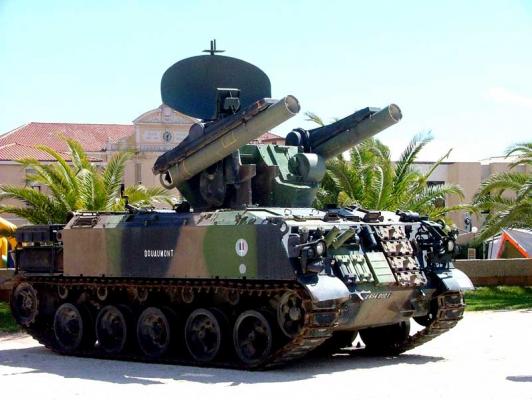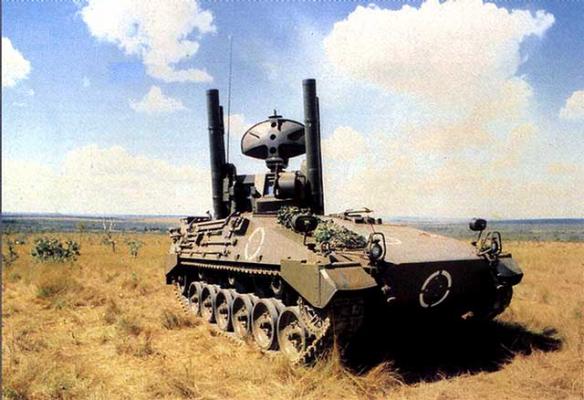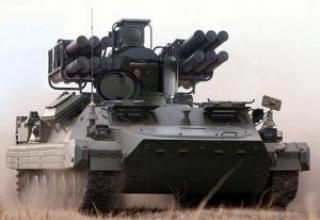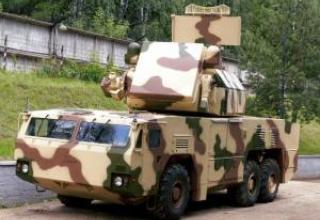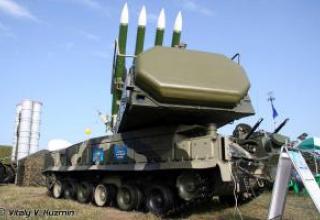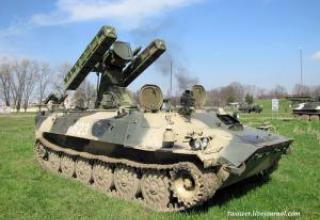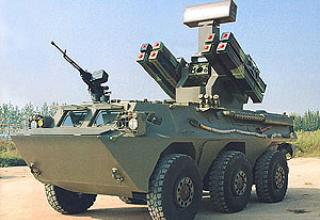In 1964, representatives of Germany and France signed an agreement to jointly develop a self-propelled SAM system "Roland", designed for air defense of mobile units in the front line and for the defense of important stationary objects in the rear of their troops. The main work on the complex was carried out by the German company "Messerchmitt-Bolkow-Blohm" (MIB) and the French company "Aerospatiale-Matra". The prototype of the complex was manufactured in 1967, and in 1974 the manufacturing companies received an order for the production of the first 240 missiles and 9 complexes with delivery date in 1976. In 1977, the system based on the AMX-30 medium tank was adopted by the French Army.
The original version of the system (later designated "Roland-1") was semi-automatic and non-weather. During the years of its service the complex was repeatedly upgraded. In 1981, the all-weather SAM system "Roland-2" was adopted for service and the program of modernization of some previously produced complexes "Roland-1" to the level of "Roland-2" was carried out (which increased the cost of the complex by 40%). In 1988 the improved automatic "Roland-3" was tested and put into production.
In Bundeswehr "Roland" SAM was placed on the chassis of the infantry fighting vehicle "Marder", produced by "Thyssen Henshel". The first tests of "Roland" complexes for the German Armed Forces were held in 1978, they were replaced by 40 mm L/70 anti-aircraft guns from Bofors. In 1981, the Bundeswehr officially received 140 Roland-2 air defense systems.
Totally about 650 Roland systems of various modifications and over 25000 missiles were produced. The complex was widely exported and is in service with the armies of France, Germany, Argentina, Brazil, Nigeria, Qatar, Spain, USA and Venezuela.
Composition:
The main equipment of the complex is assembled on a universal rotating tower unit (see layout diagram) and includes:
- radar antenna to detect air targets,
- binocular telescopic sight,
- infrared direction finder
- radio command transmission station aboard ZUR,
- two automatically controlled guides.
Inside the launcher case there are also an analogue counting and resolution device of the guidance system, a transmitter and a receiver of the detection radar, two revolver-type magazines (each with four rockets in transport and launch containers), a power supply unit, a radio station, a launch control panel and control equipment. The combat weight of the unit is about 33 tons, the crew consists of three persons (a gunner-operator, a commander-operator and a mechanic-driver).
Anti-aircraft guided missile "Roland" is made according to normal aerodynamic scheme with folding wing consoles, which open in flight springs. The rocket propulsion system consists of a booster SD1156 and a marching engine Epictete 120IA. The launch vehicle has two nozzles with nonseparating body. The charge of the launch engine (weighing 13.2 kg) is placed around the gas pipe of the marching engine. When the rocket is launched, the launch engine accelerates to 500 m/sec during 1.7 s, while the marshal engine runs for 13 s and provides a maximum flight speed of 560 m/s. The ZUR flight control is gas-dynamic and is provided by the jet deflection of the marching engine. The missile's shrapnel-cumulative warhead weighs 6.5 kg and contains 3.5 kg of explosives. It is made in the form of a cylinder, on the surface of which are dug hemispherical excavations. Shrapnel impact radius is up to 5m. The combat unit is detonated with the help of a contact or non-contact fuse, the moment of detonation of the non-contact fuse is coordinated with the diagram of splintering. In the tail part of the missile are located tracers. The rocket is launched from a fiberglass transport and launch container (GRP), the weight of which together with the ZUR 85kg, length 2.6m, diameter 0.28m. The rocket can be fired in a few seconds after the PU stops. The onboard receiver of radio commands is made on transistors. Its antennas are mounted at the rear of the tail aerodynamic surfaces. The ZUR automatically self-liquidates when the fuel of the marshal engine is burned out. Self-liquidation can be done before by a special radio command from the ground.
After the shot is fired the TPK is discharged from the rail and on command of the commander there is automatic recharging of the launcher (recharging time about 10s) by gripping the beam-holder of the next container from the magazine. These operations can be carried out independently of each other by the holder-beams. The drum-type magazines are located on the sides in the PU housing, each of them accommodates four ZUR containers and is equipped with a hydraulic drive. There are 10 missiles in a portable PU ammunition set.
Air target detection radar is a 1-2 GHz pulse Doppler station. This radar is capable of detecting targets flying at a speed of 30-500 m/s at a range of up to 18 km (with an effective reflecting area of 1 m2). Its antenna rotates at a speed of 60 rpm. On the march, the antenna is folded and fastened in a walking mode. Time of target detection does not exceed 4s. The radar also includes identification equipment "in-situ".
The control panel has a round-screen display with a scale on which the air situation is displayed, which allows the commander to select a target for firing. The formation, positioning and movement of the target display icons on the screen is provided by a fire control counter-solution device that receives information about the air situation from the detection radar. The commander selects the target to be fired by aligning the marker with its mark on the screen. This causes the tower to automatically turn in the direction that allows the SAM controls to begin operating. An audible alarm is available to unload the commander (no need to keep an eye on the screen at all times) - an alarm is triggered when a target appears. Removing or approaching the target is captured by the tone of the alarm.
The Roland-1 missile is guided by the telescope sight. It has two degrees of magnification: six- and twelvefold and can provide manual tracking of a fast-moving target with a 2-3 m RMS error. Infra-red direction finder, mounted in the sight and coaxial with it, is used to measure angular misalignment between flying ZUR and optical axis of the sight, directed by the operator to the target. For this purpose, the direction finder automatically accompanies the route of the missile, transmitting the results to the counting-solving guidance device. The sighting device generates commands for pointing the SAM using the "cover target" method. These commands are transmitted to the LSD via the antenna of the transmitting station.
The Roland" SAM system is designed to fire targets flying at a speed of up to 440 m/sec in the altitude range from 0.02 to 3 km at ranges from 0.5 to 6.2 km. The calculated probability of engagement of one missile against a target flying at a speed of 300 m/sec is not less than 0.5 with a direct hit probability of 0.16-0.25.
Characteristics:
| Range of fire, km | |
| - minimum | 0.5 |
| - maximum | 6.2 |
| Target kill altitude, km | |
| - minimum | 0,02 |
| - maximum | 3 |
| The Roland rocket. | |
| Starter weight, kg | 62.5 |
| Length, mm | 2400 |
| Maximum housing diameter, mm | 160 |
| Weight of combat unit, kg | 6.5 |
| Maximum flight speed, m/s | 560 |
Testing:
The anti-aircraft missile regiment of the "Roland" SAM system is designed to provide air defense of the first tier of the army corps. The French army corps has two types of such regiments - anti-aircraft missile and anti-aircraft missile artillery. The anti-aircraft missile regiment consists of a control and maintenance battery, four fire batteries. In the regiment 980 people, 32 PU ZUR "Roland", 32 armored VAB and 184 vehicles for various purposes. The anti-aircraft missile and artillery regiment includes a control and maintenance battery, three SAM batteries and a SAM battery. The regiment includes 24 Roland SAM batteries, 12 30 mm self-propelled air defense systems, 24 VAB armored personnel carriers and 150 vehicles. The number of personnel in the regiment is 980 (both types of regiments provide for two reserve launchers of SAM systems and two armored personnel carriers).
The main combat unit of the regiments are Roland SAM batteries consisting of two platoons (each has four launchers). The platoon provides air defense (cover) of the 100 km2 section and up to 12 km of the route when marching. Platoon launchers usually operate at a distance of 3-4 km from each other. According to the Western press, each anti-aircraft missile regiment of the Roland SAM system is capable of providing air cover for two first tier regiments engaged in offensive or defensive actions.
Argentina used a stationary version of the Roland complex in the Falkland War of 1982 to protect the city of Port Stanley from airstrikes by British naval aviation. Between 8 and 10 missiles were fired, and information about the effectiveness of the Roland system in this conflict is quite contradictory. According to French data, the Argentineans used the Roland SAM system to shoot down 4 and damage 1 Harrier. However, according to other information, only one aircraft can record two 454-kg bombs, three Harriers were destroyed by anti-aircraft artillery fire and one by a Blowpipe man-portable air defence system. During the landing of British troops, the complex was seized intact.
Iraq also used its Roland complexes in the war against Iran.
Sources:
- Василин Н.Я., Гуринович А.Л. "Зенитные ракетные комплексы" .-Мн.: ООО "Попурри", 2002- 464с.
- Толин А. "Артиллерийские зенитные установки". Зарубежное военное обозрение №1, 1985
- AMX 30 Roland
- ЗРК "Roland" /Вестник ПВО/
- Marder Roland no Exercito Brasileiro 1977 - 2002
